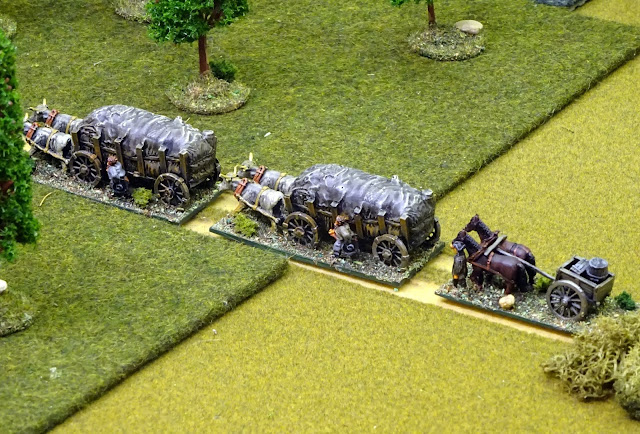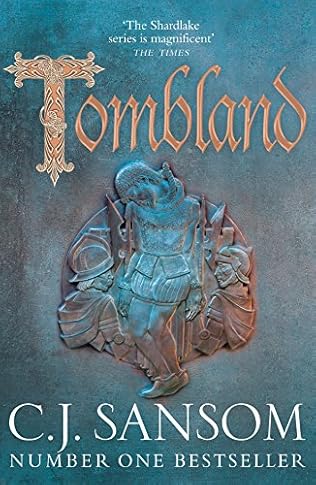With the arrival of DG in the south for the weekend's Warfare trip, as is usual with us we looked to slip in a quick game while he was down, and thoughts soon returned to that all too
dissatisfying game [clicky] we had for the John Corrigan Memorial a few months ago.. the scenario was superb but balance of play with a randomised force had lead to a somewhat one sided game.. We'd had some idea's about the OOB's being more balanced as in this game cavalry is key, and these were used as the basis for this game...
So it was, that with the table still set from last time, I suggested we play again, but this time in either 15mm War of the Spanish Succession mode or 20mm American Civil War mode; DG agreed and requested Marlburian..
With the table still set up from last time (I love having a permanent wargame table away from the hustle up in the loft!) all I needed to do was swap out the 25mm terrain pieces for 15mm - the table thus became as follows:
Quick reminder:
- all forces arrive via the town (in this case on the picture above Allies left, French right) and the town is worth one point to the home team, and 3 points to their opponents (if they can take it)
- the hill mid table top is worth 3 pts.
- the two other hills are worth 1 pt. each
- the farm/barn is worth 6 pts.
- all hills are gentle slopes, the woods (centre of table only marked by the green square outline) are classed as 'dense' - all other tree's are just for show
- the wheat fields are 'disordered ground' - other than them, the hills, and the woods, everything else is good going - we didn't play a road bonus..
We then diced for sides, and DG chose the French giving me the Allies. He also opted to use the entry on the right in the picture above.
I had diced for OOB before the game (to save time) on a random table and had come up with a 12 unit force that comprised
- 6 battalions of regular infantry - no morale bonus
- 4 squadrons of regular cavalry - again no morale bonus
- 2 batteries of artillery - medium - again no morale bonus
- 2 Brigadiers
- 1 General
..we ignored any national characteristics so the forces were entirely equal.
Game length – 12 turns - from turn 13 throw 2D6 scoring 9 or more for the
game to end that move - for each subsequent move deduct one from the
total needed (randomness being what it is you should get a game of 14 to
16 turns..)
On to the game...
The first tactical challenge with this scenario is deciding what order to bring your troops on in, as the only entry point is the road.. DG's road jam can be seen top right.. both of us had learnt from the last game though, and both sides had pump primed the advance guard with cavalry, and in both our cases the first target was also the food source ie. the barn..
 |
| Move 1 - cavalry to the fore heading for the barn while n innocent civilian supply train (empty) leaves |
I had all four squadrons of my cavalry come on first, followed by three infantry, a gun, the rest of the infantry, and then finally the other gun.. my thinking was that the artillery moved slower than everything else so I was going for speed.. in hindsight I'm not sure that was the best idea as it meant I was missing the ability to hit out at distance until about move 4 or 5.....

 |
| Three squadrons of Queen Anne's finest... |
 |
| Departing supply wagons... empty... table colour only, and not specific to the scenario |
Not 100% sure what DG opted for but I think he parcelled up his troops a bit more than I did.. two cavalry followed by three infantry certainly led the advance, then a gun I think but after that I am unclear.. what I am sure of is that his artillery was in action before mine were..
 |
| "Vive le Roi!" French advance guard.. |
Couple of moves later (next) and DG has taken the time to change his cavalry to line while I am still going at full whack in column.. at this point we adjudged that both sides had taken their respective single hills (1 pt each) and with the control of the town (also 1 pt each) honours were even..
Four or five moves later (following)... British infantry wends its way through the town to the front line in the far distance...
So, same move, and an explanation of my plan (such as it was, as it changed throughout the game!

) ... the intent was for the first two squadrons of cavalry (which we saw previously) to deny DG the barn while my main force was directed at the the three point hill, and
possibly DG's town depending on what he did.. the following then, shows the main force with cavalry to the fore..
Same move.. DG was clearly making a major effort for the barn (you can see his infantry columns in the distance), and that changed my plans, especially as he had reinforced his town and was making a fairly major effort to deny me the big (3 pt'er) hill..
Next - the action at the barn hots up..British cavalry had deployed to line - they didn't have the ability to occupy the barn, but there job was to ensure DG didn't..
....which I think it fair to say they fairly comprehensively failed to do!

Couple of moves later (next) and the British cavalry has been seen off by their triumphant French counterparts... not a complete failure (you can see one of DG's squadrons withdrawing in some discomfort the other side of the wood) but the important thing is that DG has control of the field.. and I do not... he has 6 pts for the taking, unless I do something, and those two columns of infantry he has are not hanging around despite taking the scenic route..
Plans change then - two battalions of my infantry have been sent down the road between the woods - in the distance I make an effort for the big hill (which also protects their flank)
Two vs one should be enough right?

My artillery is also coming up.. all is not lost...
A few moves later (next) and a fine example of the swings and roundabouts of this excellent game... 3pt'er hill first and that two versus one didn't help... one of my squadrons was sent off in a state of discombobulation (though they have recovered far left in this picture) and the other squadron is 'disquieted'

(yellow pin = "shaken" - the cause was artillery fire from DG's gun in his town, I think)
At the barn. my horse recovers and see's off the French cavalry but they are weak now and in no condition to stop DG's infantry advance.. I've reinforced the infantry reserve advancing on the barn, and the first battalion has shaken out into line..

A few moves later and the denouement approaches.. that weak British cavalry has been sent packing (red pin = rout), DG has protected his flanks and has cavalry reinforcements, and is facing off the to the first allied battalion - bottom right you can just see one of DG's infantry battalions occupying the barn..
...the battle for the 3pt'er hill hangs in the balance.. so at this point with 8 pts to DG, and 2 pts to me, and a few moves over the scenario end we declared it a French win..
Post match analysis
- Better tactics won the day - DG is an infantry man and looks to the long picture, I however am your archetypal British cavalry man - "charging at everything"

- The eagle eyed among you may have spotted we played longer than the scenario, but that was because as it turned out we didn't think it was long enough and when the game officially 'ended', it was a draw, despite DG being in a commanding position - so we played on a few more moves..

- Refreshments on the night was a couple of pints of the truly splendid Hobgoblin IPA..




































